IL study of eyes, known professionally as ophthalmology, is a fascinating field that explores the complex organs responsible for our vision. Your eyes are remarkable sensory organs that capture light from the world around you and transform it into electrical signals your brain can interpret. This comprehensive guide will take you through the intricate anatomy, function, and care of your eyes, helping you understand why eye health is crucial to your overall wellbeing.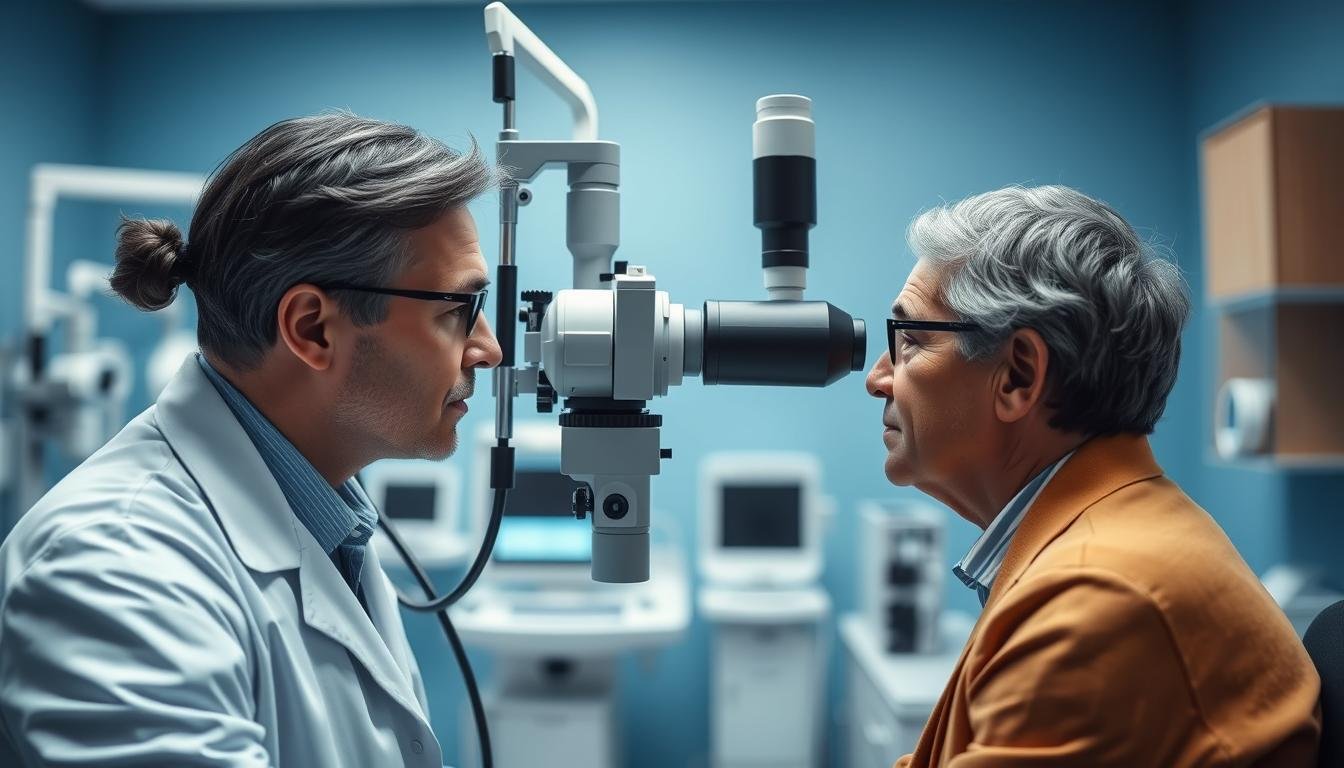
What Is the Studio degli occhi? A Comprehensive Overview
IL study of eyes encompasses multiple disciplines including ophthalmology, optometry, and visual neuroscience. This field examines everything from the physical structures of the eye to how vision works and the treatment of eye-related conditions.
An ophthalmologist conducting a comprehensive eye examination
Ophthalmologists are medical doctors who specialize in eye and vision care. They undergo extensive training, including four years of medical school and at least four additional years of specialized training. Optometrists, while not medical doctors, are eye care professionals who provide primary vision care, including sight testing and correction. Opticians are technicians who design, verify, and fit eyeglass lenses and frames, contact lenses, and other devices to correct eyesight.
Preoccupato per la salute degli occhi?
Regular eye examinations are essential for maintaining good vision and detecting potential problems early. Our specialists can provide comprehensive eye care tailored to your needs.
Pianifica un esame oculistico oggi
Key Components in the Studio degli occhi: From Cornea to Retina
Understanding eye anatomy is fundamental to the study of eyes. The human eye is a complex organ with many interconnected parts working together to provide vision.
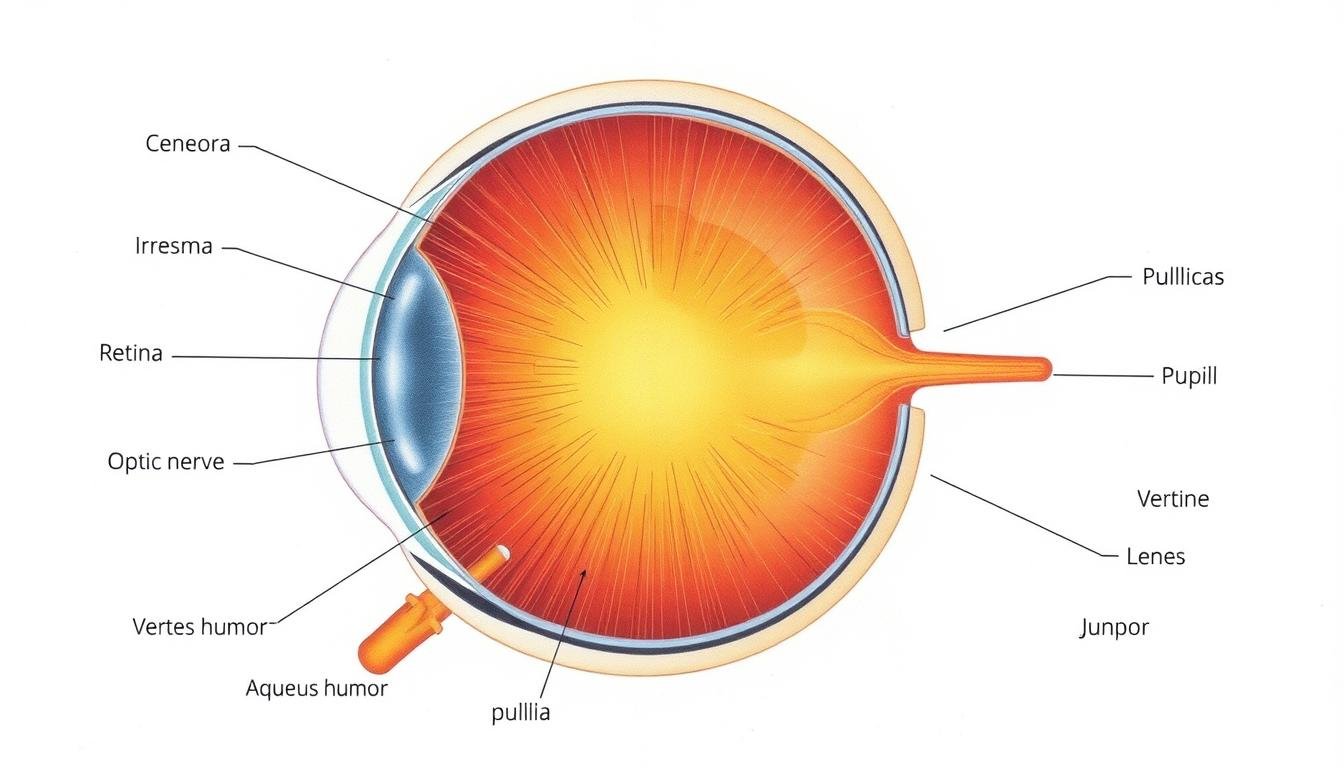
Cross-section of the human eye showing major anatomical structures
External Eye Structures in the Studio degli occhi
The external structures protect the eye and help direct light to the retina:
- Cornea: The clear, dome-shaped surface that covers the front of the eye. It acts like a window, allowing light to enter while protecting the eye from dust and germs.
- Sclera: The white part of the eye that forms the eye’s outer wall and helps maintain its shape.
- Conjunctiva: A thin, transparent tissue that covers the sclera and lines the inside of the eyelids.
- Iris: The colored part of the eye that controls the size of the pupil, regulating how much light enters.
- Pupil: The black circle in the center of the iris that changes size to control how much light reaches the retina.
Internal Eye Structures
The internal components focus light and convert it into electrical signals:
- Lens: Located behind the iris, it focuses light onto the retina. It changes shape to help you focus on objects at different distances.
- Aqueous humor: Clear fluid that fills the space between the cornea and iris, providing nutrients and maintaining eye pressure.
- Vitreous humor: A clear, gel-like substance that fills the space between the lens and retina, helping the eye maintain its shape.
- Retina: The light-sensitive layer at the back of the eye containing photoreceptor cells (rods and cones) that convert light into electrical signals.
- Macula: A small area in the center of the retina responsible for central vision and seeing fine details.
- Fovea: A tiny depression in the center of the macula that provides the sharpest vision.
- Optic nerve: Carries visual information from the retina to the brain.
How Vision Works: The Science Behind the Studio degli occhi
Vision is a complex process that begins when light enters the eye and ends with your brain interpreting what you see.
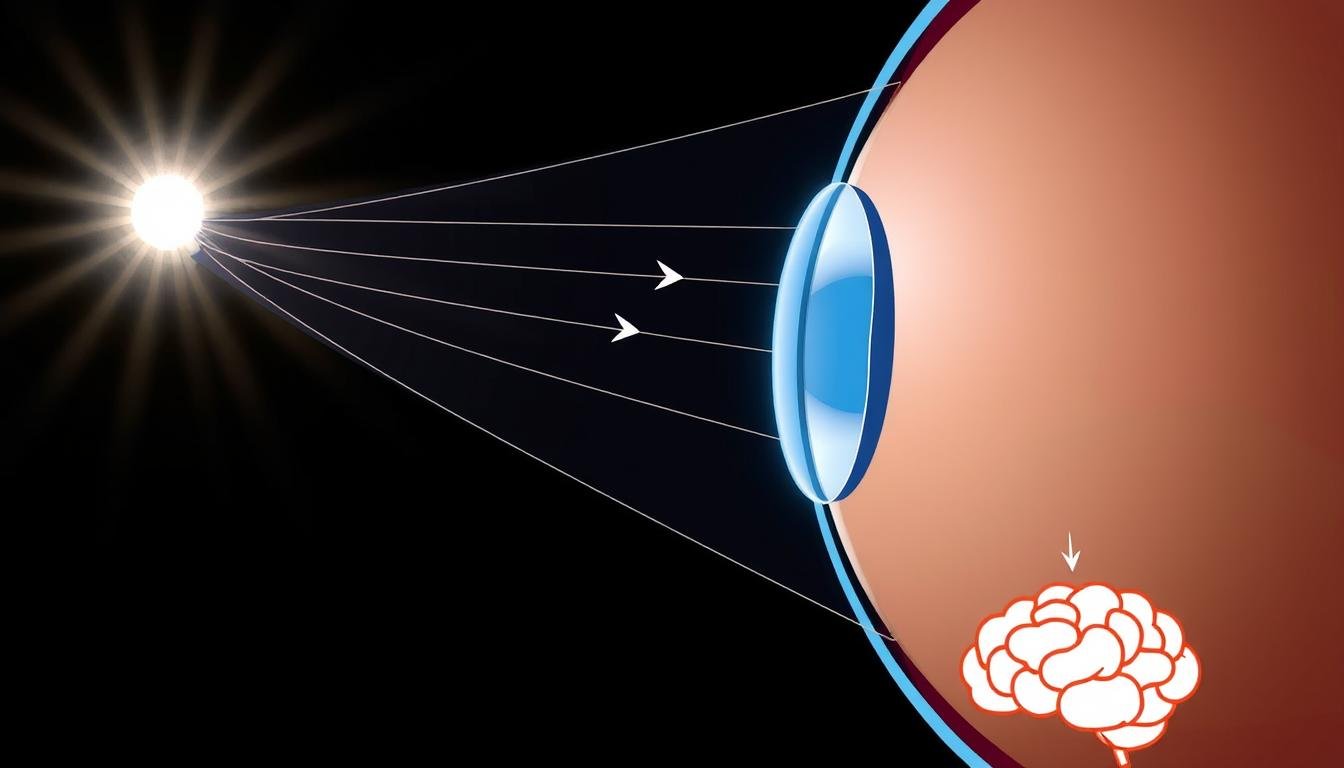
The path of light through the eye and visual processing in the brain
The Visual Pathway
Here’s how the process works:
- Light enters the eye through the cornea, which bends (refracts) the light.
- The light passes through the aqueous humor and the pupil, which adjusts its size to control the amount of light entering.
- The light then passes through the lens, which further focuses it.
- After passing through the vitreous humor, the light reaches the retina.
- Photoreceptor cells in the retina (rods and cones) convert light into electrical signals.
- These signals travel through the optic nerve to the brain.
- The brain processes these signals in the visual cortex, creating the images you see.
“The eye is the jewel of the body, the window to the soul, and the mirror of the world.” – This ancient saying reflects how the study of eyes has been valued throughout human history for both medical and philosophical reasons.
– Traditional Proverb
Rods and Cones: The Photoreceptors
The retina contains two types of photoreceptor cells:
Rods
- About 120 million in each eye
- Responsible for vision in low light conditions
- Provide peripheral vision
- Cannot detect color
Cones
- About 6-7 million in each eye
- Function best in bright light
- Provide color vision and detail
- Concentrated in the macula, especially the fovea
Experience Vision Problems?
If you’re experiencing changes in your vision, it’s important to consult with an eye care professional. Early detection of vision problems can prevent further complications.
Trova uno specialista degli occhi vicino a te
Historical Milestones in the Studio degli occhi
IL study of eyes has evolved significantly throughout history, with numerous breakthroughs that have advanced our understanding of vision and eye health.
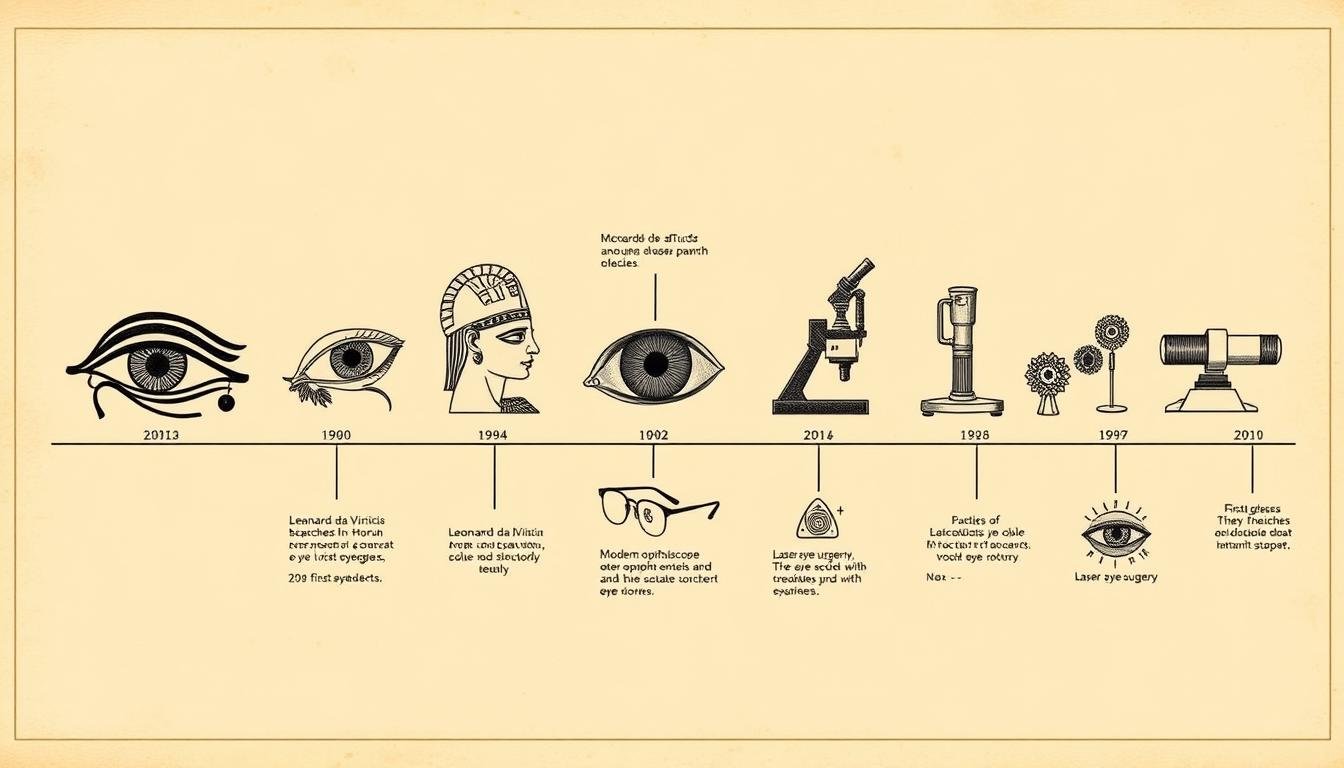
Timeline of major developments in ophthalmology throughout history
Ancient Beginnings
The earliest records of the study of eyes date back to ancient civilizations:
- 2000-3000 BCE: Ancient Egyptians documented eye diseases and treatments in the Ebers Papyrus.
- 500-300 BCE: Hippocrates and other Greek physicians described various eye conditions and proposed treatments.
- 1st century CE: Roman physician Aulus Cornelius Celsus detailed cataract surgery techniques.
Renaissance to Modern Era
Significant advancements occurred during and after the Renaissance:
- 1286: The first eyeglasses were invented in Italy.
- 1500s: Leonardo da Vinci studied the anatomy of the eye and proposed theories about vision.
- 1851: Hermann von Helmholtz invented the ophthalmoscope, allowing doctors to examine the retina.
- 1905: Eduard Zirm performed the first successful corneal transplant.
- 1949: Harold Ridley implanted the first intraocular lens during cataract surgery.
- 1961: The first laser treatment for retinal conditions was developed.
- 1987: The first excimer laser refractive surgery was performed.
Modern Technologies Revolutionizing the Studio degli occhi
Today’s study of eyes benefits from cutting-edge technologies that allow for more precise diagnosis and treatment of eye conditions.

Advanced diagnostic imaging technology used in modern ophthalmology
Diagnostic Technologies
These technologies have transformed how eye specialists examine and diagnose eye conditions:
- Optical Coherence Tomography (OCT): Provides cross-sectional images of the retina with microscopic detail.
- Digital Retinal Photography: Captures detailed images of the retina to document eye health and track changes over time.
- Corneal Topography: Maps the surface curvature of the cornea to diagnose conditions and assist in contact lens fitting.
- Visual Field Testing: Measures peripheral vision to detect vision loss from glaucoma and other conditions.
- Wavefront Analysis: Measures how light travels through the eye to detect subtle vision abnormalities.
Treatment Technologies
Advanced technologies have also revolutionized eye treatments:
- Laser Surgery: Used for various procedures including LASIK for vision correction and treatments for glaucoma and retinal conditions.
- Femtosecond Laser: Creates precise incisions for cataract surgery and corneal transplants.
- Intraocular Lenses (IOLs): Advanced lens implants that can correct vision after cataract removal.
- Anti-VEGF Therapy: Injectable medications that treat wet macular degeneration and diabetic retinopathy.
- Gene Therapy: Emerging treatments for inherited retinal diseases.
Interested in Advanced Eye Care Options?
Modern eye care technologies can address a wide range of vision problems and eye conditions. Consult with a specialist to learn which options might be right for you.
Explore Treatment Options
Common Eye Conditions in the Studio degli occhi
IL study of eyes includes understanding various conditions that can affect vision and eye health.

Comparison of a healthy eye versus eyes affected by common conditions
Refractive Errors
These common vision problems occur when the eye cannot focus light correctly:
Myopia (Nearsightedness)
Distant objects appear blurry while close objects remain clear. Occurs when the eyeball is too long or the cornea is too curved.
Hyperopia (Farsightedness)
Close objects appear blurry while distant objects may be clearer. Occurs when the eyeball is too short or the cornea is too flat.
Astigmatism
Blurred or distorted vision at all distances due to irregular curvature of the cornea or lens.
Age-Related Eye Conditions
Several eye conditions become more common as people age:
- Presbyopia: Age-related loss of near vision, typically beginning around age 40.
- Cataracts: Clouding of the eye’s lens, causing blurry vision and increased sensitivity to glare.
- Glaucoma: A group of eye conditions that damage the optic nerve, often due to increased pressure in the eye.
- Age-Related Macular Degeneration (AMD): Deterioration of the macula, affecting central vision.
- Dry Eye: Insufficient tear production or poor tear quality, causing discomfort and potential vision problems.
Other Common Eye Conditions
IL study of eyes also encompasses these conditions:
- Diabetic Retinopathy: Damage to blood vessels in the retina due to diabetes.
- Retinal Detachment: Separation of the retina from the back of the eye, requiring immediate treatment.
- Amblyopia (Lazy Eye): Reduced vision in one eye due to abnormal visual development in childhood.
- Strabismus: Misalignment of the eyes, where they point in different directions.
- Conjunctivitis (Pink Eye): Inflammation of the conjunctiva, often due to infection or allergies.
Warning Signs: Seek immediate medical attention if you experience sudden vision loss, eye pain, double vision, flashes of light, or a sudden increase in floaters. These could indicate serious conditions requiring prompt treatment.
Eye Care and Prevention in the Studio degli occhi
Maintaining good eye health is a crucial aspect of the study of eyes. Preventive care can help preserve vision and detect problems early.

Proper eye protection is essential during activities that pose risks to eye safety
Essential Eye Care Practices
These habits can help maintain healthy eyes throughout your life:
- Regular Eye Exams: Adults should have comprehensive eye exams every 1-2 years, or more frequently if recommended by an eye care professional.
- Proper Nutrition: Eat a diet rich in fruits and vegetables, especially dark leafy greens like spinach and kale. Omega-3 fatty acids, found in fish like salmon, can also benefit eye health.
- Protect Your Eyes: Wear sunglasses that block 99-100% of UVA and UVB radiation when outdoors. Use appropriate eye protection during hazardous activities.
- Rest Your Eyes: Follow the 20-20-20 rule when using digital devices: Every 20 minutes, look at something 20 feet away for 20 seconds.
- Quit Smoking: Smoking increases the risk of cataracts, macular degeneration, and optic nerve damage.
- Control Chronic Conditions: Manage conditions like diabetes and hypertension, which can affect eye health.

Foods rich in nutrients that support eye health
When to See an Eye Care Professional
Schedule an appointment if you experience any of these symptoms:
- Decreased vision, even if temporary
- Eye pain or increased sensitivity to light
- New floaters (spots) or flashes in your vision
- Redness or swelling of the eye or eyelid
- Double vision
- Distortion or waviness in your vision
- Halos around lights
- Frequent headaches or eye strain
Protect Your Vision for Life
Regular eye examinations are essential for maintaining healthy vision and detecting potential problems before they affect your sight.
Prenota oggi il tuo esame oculistico
Career Paths in the Studio degli occhi
IL study of eyes offers diverse career opportunities for those interested in vision and eye health.
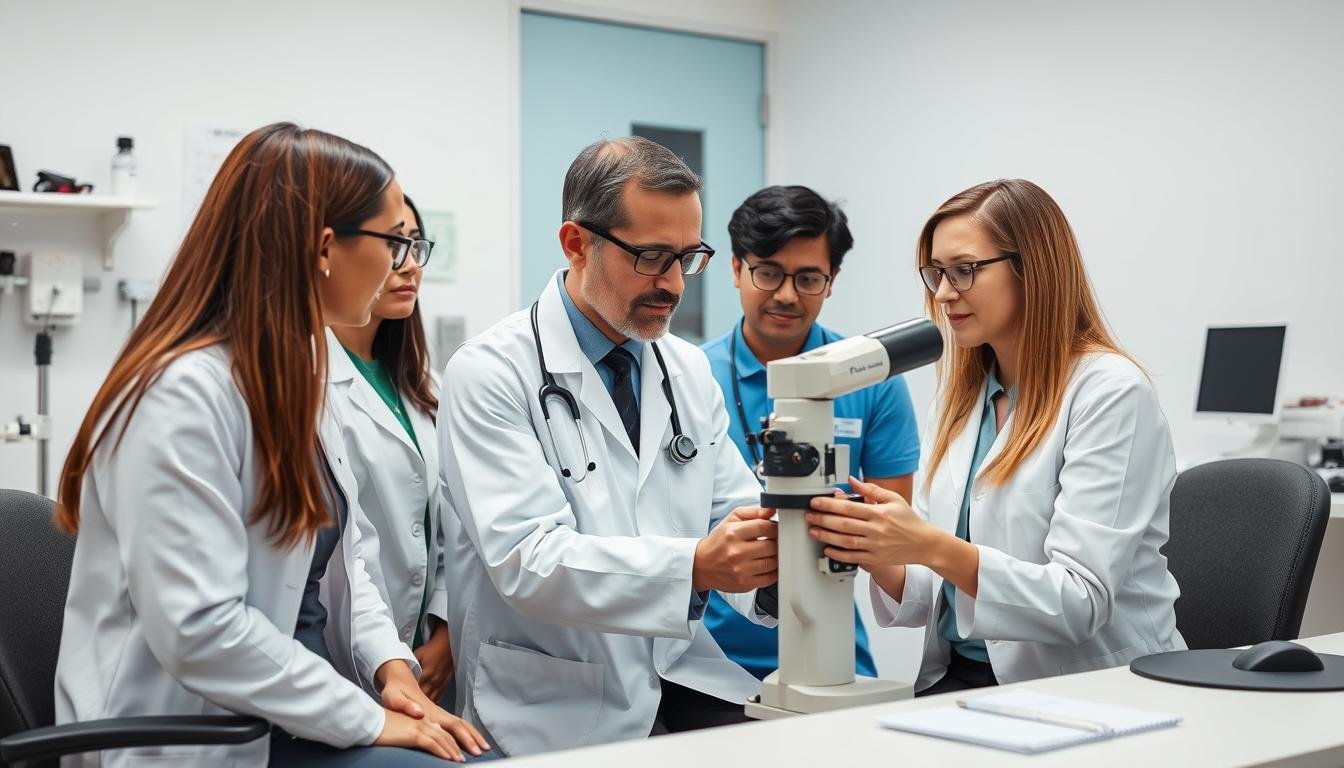
Various eye care professionals working together in a modern eye clinic
Professional Roles in Eye Care
These specialists play different but complementary roles in eye care:
| Professionale |
Education Required |
Primary Responsibilities |
Can Prescribe Medication |
Can Perform Surgery |
| Ophthalmologist |
Medical school (MD) + 4+ years residency |
Complete eye care, diagnosis and treatment of eye diseases, eye surgery |
SÌ |
SÌ |
| Optometrist |
Doctor of Optometry (OD), 4 years after bachelor’s |
Vision tests, prescribe corrective lenses, diagnose eye conditions |
Limited (varies by state) |
No (minor procedures in some states) |
| Optician |
1-2 years training/certification |
Fit and dispense eyeglasses and contact lenses |
NO |
NO |
| Ophthalmic Technician |
Certificate or associate degree |
Assist ophthalmologists, perform preliminary tests |
NO |
NO |
| Vision Researcher |
PhD or MD/PhD |
Conduct research on eye diseases and treatments |
Depends on credentials |
Depends on credentials |
Ophthalmology Subspecialties
Ophthalmologists can further specialize in specific areas:
- Cornea and External Disease: Focus on conditions affecting the cornea, conjunctiva, and eyelids.
- Glaucoma: Specialize in preventing and treating glaucoma.
- Neuro-ophthalmology: Study disorders of the optic nerve and visual pathways.
- Oculoplastics: Perform reconstructive and cosmetic surgery around the eyes.
- Pediatric Ophthalmology: Specialize in children’s eye conditions.
- Retina: Focus on diseases affecting the retina, including diabetic retinopathy and macular degeneration.
- Uveitis and Ocular Immunology: Treat inflammatory eye diseases.
Frequently Asked Questions About the Studio degli occhi
Here are answers to common questions about eye health and vision care.

Regular eye examinations are an important part of preventive eye care
How often should I have my eyes examined?
For adults with no symptoms or risk factors for eye disease, the American Academy of Ophthalmology recommends a comprehensive eye exam every 1-2 years for those over 65, and every 2-4 years for those aged 40-54. People with diabetes, high blood pressure, or a family history of eye disease may need more frequent exams. Children should have their first comprehensive eye exam at 6 months, another at age 3, and again before starting school.
Can eye exercises improve my vision?
Eye exercises cannot correct refractive errors like nearsightedness, farsightedness, or astigmatism. However, certain exercises may help with eye strain and can be beneficial for specific conditions like convergence insufficiency (difficulty focusing both eyes together for near work). Always consult with an eye care professional before starting any eye exercise program.
Is it true that carrots improve eyesight?
Carrots are rich in vitamin A, which is essential for good vision. However, eating carrots won’t improve your vision if you already have adequate vitamin A in your diet. A balanced diet with a variety of fruits and vegetables provides the nutrients necessary for eye health, including vitamins A, C, and E, zinc, lutein, zeaxanthin, and omega-3 fatty acids.
Can reading in dim light damage my eyes?
Reading in dim light does not damage your eyes permanently, but it can cause temporary eye strain and fatigue. Symptoms may include dry eyes, blurred vision, headaches, and difficulty concentrating. To reduce eye strain, ensure adequate lighting when reading or doing close work.
What is the difference between an ophthalmologist, optometrist, and optician?
An ophthalmologist is a medical doctor (MD) who specializes in eye care, can diagnose and treat all eye diseases, perform surgery, and prescribe medications. An optometrist has a Doctor of Optometry (OD) degree, can perform eye exams, prescribe corrective lenses, diagnose certain eye conditions, and in some states, prescribe medications for some eye diseases. An optician is trained to design, verify, and fit eyeglass lenses and frames, contact lenses, and other devices to correct eyesight, but does not diagnose or treat eye conditions.
Have More Questions About Your Eye Health?
Our eye care specialists are here to answer your questions and provide personalized care for your vision needs.
Contact an Eye Specialist
Conclusion: The Importance of the Studio degli occhi
IL study of eyes is a fascinating and vital field that continues to evolve with new research and technologies. Understanding how your eyes work and taking proper care of them is essential for maintaining good vision throughout your life.
From the intricate anatomy of the eye to the complex process of vision, from historical developments to cutting-edge treatments, the field of ophthalmology offers valuable insights into one of our most precious senses. By staying informed about eye health and seeking regular professional care, you can protect your vision and address any concerns before they become serious problems.
Remember that your eyes are not just windows to the world—they can also provide important clues about your overall health. Many systemic conditions, such as diabetes, hypertension, and autoimmune disorders, can manifest with eye symptoms. This makes regular eye examinations an important part of your overall healthcare routine.

Maintaining good eye health contributes to quality of life at all ages
Take the First Step Toward Better Eye Health
Whether you’re experiencing vision changes or simply due for a check-up, our eye care professionals are ready to help you maintain healthy vision for life.
Schedule Your Comprehensive Eye Exam























